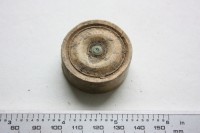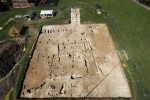 Archaeologists with the University of Reading excavating an Anglo-Saxon royal complex at Lyminge, Kent, have unearthed an extremely rare board game piece dating to the 7th century. It’s the first discovery of this particular form of gaming piece in 130 years, and it’s the only time one has ever been found outside of a burial context. This one was unearthed in a room adjacent to the feasting hall, a place where it would actually have been used in active play rather than as a ceremonial grave good.
Archaeologists with the University of Reading excavating an Anglo-Saxon royal complex at Lyminge, Kent, have unearthed an extremely rare board game piece dating to the 7th century. It’s the first discovery of this particular form of gaming piece in 130 years, and it’s the only time one has ever been found outside of a burial context. This one was unearthed in a room adjacent to the feasting hall, a place where it would actually have been used in active play rather than as a ceremonial grave good.
Alongside this astonishing discovery, Dr Gabor Thomas and his team have also uncovered items of jewellery, numerous fragments of luxury vessel glass and pits with animal bones, confirming that feasting and social display were integral to Lyminge’s role as a place of royal ceremonial events and gatherings during the late 6th and 7th centuries.
Dr Gabor Thomas from the University’s Department of Archaeology is leading the Arts and Humanities Research Council funded dig. He said: “Our excavation is providing an unprecedented picture of life in an Anglo-Saxon royal complex. Gaming, along with feasting, drinking, and music, formed one of the key entertainments of the Anglo-Saxon mead-hall as evoked in the poem Beowulf.
“The discovery of Anglo-Saxon gaming-pieces and gaming-boards has previously been restricted to male burials, particularly those of the Anglo-Saxon elite. To find such a well preserved example in the hall, where such board games were actually played, is a wonderfully evocative discovery.”
 The piece is a made of a hollow tube of bone capped at both ends with bone discs held together through the middle by a copper alloy rivet. Anglo-Saxons were fond of a board game and a number of pieces, even sets, have been found, but this kind of craftsmanship is top of the line. The only comparable pieces of this type ever discovered in Britain were found in the Taplow burial, a 7th-century Anglo-Saxon princely burial mound in Taplow Court, Buckinghamshire, that was excavated in 1883. The grave goods interred at Taplow include a pair of drinking vessels made out of aurochs’ horns with elaborate gilded silver fittings, a gorgeous set of four glass claw beakers, a lyre, multiple weapons, gold braids, a gold and garnet belt buckle and a set of game pieces laid out at the prince’s feet. The Taplow burial is contemporary in age with the Sutton Hoo burial and the artifacts are of a same high level of quality.
The piece is a made of a hollow tube of bone capped at both ends with bone discs held together through the middle by a copper alloy rivet. Anglo-Saxons were fond of a board game and a number of pieces, even sets, have been found, but this kind of craftsmanship is top of the line. The only comparable pieces of this type ever discovered in Britain were found in the Taplow burial, a 7th-century Anglo-Saxon princely burial mound in Taplow Court, Buckinghamshire, that was excavated in 1883. The grave goods interred at Taplow include a pair of drinking vessels made out of aurochs’ horns with elaborate gilded silver fittings, a gorgeous set of four glass claw beakers, a lyre, multiple weapons, gold braids, a gold and garnet belt buckle and a set of game pieces laid out at the prince’s feet. The Taplow burial is contemporary in age with the Sutton Hoo burial and the artifacts are of a same high level of quality.
The game pieces were almost certainly an import from Germanic Europe, most likely of Langobardic manufacture. The most apt parallels have been found in the Lombard kingdom of Italy. Saxons were part of the Lombard invasion force of Italy in the late 6th century, and it’s probable these luxury goods made their way up north through trade routes that ranged as far as the Byzantine Empire.
 The Lyminge game piece was discovered by a volunteer. He’s a metal detectorist who works side by side with the archaeologists exploring the site as they dig. He wasn’t actually using his metal detector the time. He was digging in a trench in the spot where several buildings in the complex intersect when he found this small but immensely important artifact. The structural evidence reveals a complex with large timber halls, floors made out of Roman-style mortar with opus signinum, a crushed tile finish, and huge entrance portals larger than any other from this period unearthed in England.
The Lyminge game piece was discovered by a volunteer. He’s a metal detectorist who works side by side with the archaeologists exploring the site as they dig. He wasn’t actually using his metal detector the time. He was digging in a trench in the spot where several buildings in the complex intersect when he found this small but immensely important artifact. The structural evidence reveals a complex with large timber halls, floors made out of Roman-style mortar with opus signinum, a crushed tile finish, and huge entrance portals larger than any other from this period unearthed in England.
As far as what games the royal hall denizens might have been playing with these pieces, we don’t know. There are no written descriptions of the fine sport to be had in the feasting halls of Anglo-Saxon royalty. What we have to go on is archaeological evidence from the Germanic burials pre-dating the Anglo-Saxon takeover of England. One burial in Leuna, Saxony, dating to around 300 A.D., contained a set of black and white pieces on a double-sided wooden board. This was used to play two games: tabula, an early form of backgammon, and latrunculi (soldiers), a checkers-like game wherein matched sides attempt to capture each other’s pieces. These games were brought to England in the fifth century during the Anglo-Saxon migrations.
For more photographs of this season’s and the previous four years of excavation at Lyminge, see this photo gallery.
There are certain activities that make me feel connected to all of humanity past and present, and board games are one of them (along with baking bread). It’s not even woo, just “Millions of people have done this exact activity that I am doing” and I think it’s very cool.
Too bad we can’t find a description of the gameplay